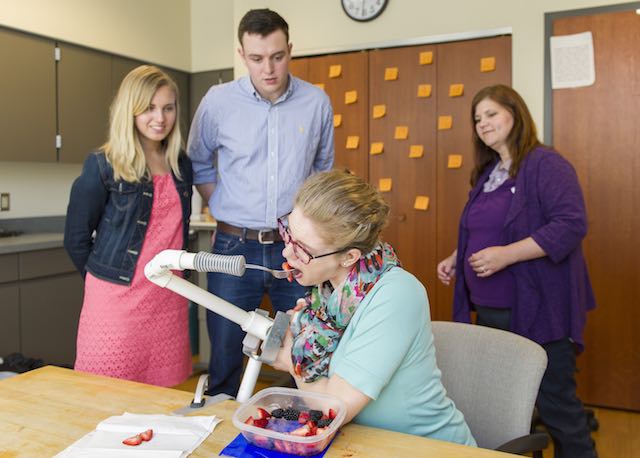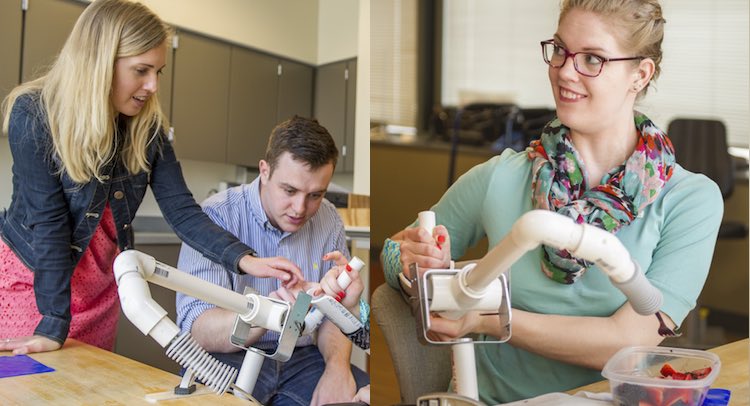Katelyn Toth and her stepbrother were riding a paddleboat on a small lake near Bremen, Indiana, in 2006 when a storm whipped out of nowhere and unleashed a lightning bolt, the lone strike in a 60-mile radius.
While her stepbrother suffered only a slight shock, Katelyn took the full force of the sudden strike and suffered third-degree burns across her face, neck and torso.
The 12-year-old – who loved softball, played the clarinet, and once brought 27 frogs home to her basement – was not expected to live. She was airlifted to two different hospitals. She lingered in a coma-like state for months, her brain severely shocked. Doctors at a special burn unit in Kalamazoo, Michigan, told her mother, Julie Noblitt, that Katelyn would never walk or talk again.
EXTREME DESIGN: Would You Cross This Glass Walkway Suspended 1000-ft Over a Canyon?
“She brings a lot of light when we go places,” Julie says of her daughter. “I call it her light. It’s an aura, how she projects energy. Her determination. It just draws people to her and makes them smile.”
A group of Notre Dame engineering students, drawn to Katelyn’s light, spent this semester experimenting on how to help her with another step in her recovery: eating on her own. Now 22 years old, she has control of her arms when held close to her torso, but when she extends them, ongoing nerve damage causes tremors that make controlling a fork or spoon nearly impossible.
“When we eat out at a restaurant, I’ve seen her turn away from the other people there so they can’t see her being fed and eating,” Julie said. “It breaks my heart. This project is about self-esteem, giving her the control to eat on her own.”
CREATIVITY: Listen To This Concrete Organ Played By The Ocean (WATCH)
The students took two different approaches. Emily Cunningham led a team focused on adapting a robotic arm. Michael Boyle led a simpler, mechanical approach that involved PVC pipe pieces to extend Katelyn’s reach.
“She has this beautiful blond hair with a delicate braid that shows her mom is so loving,” Cunningham said. “Katelyn works really hard in therapy, but you can tell eating is frustrating. It would be wonderful for her to get that sense of freedom back.”
Cunningham and Boyle are working with Katelyn through a one-credit course at Notre Dame called Student Engineers Reaching Out (SERO), which grew out of a national service-learning design program in which teams of students partner with local service organizations to address human and community needs. Paul Brenner, associate director of the Center for Research Computing and associate professor of computer science and engineering, volunteers as the faculty mentor of the class of about 10 students.
RELATED: Teen Turns Body Brace into Steampunk Fashion Statement
“It gives a purpose to what we do as engineers,” Brenner said. “It’s a way to apply their learning that can help when they are sitting in their third calculus class and they’re overwhelmed with technical aspects. They also like helping the community.”
Every Tuesday night, session are held in a machine shop. They call the session “Toys” because their longest-running project is adapting toys for children with physical limitations at area hospitals. Activities include putting larger buttons on an MP3 player, building foot straps and different steering handles for toy cars the kids ride, and rewiring larger on-off switches. They even 3-D print special parts to make a toy truck easier to control.
MORE: Designer’s Air Purifier Converts Smog Into Jewelry As it Cleans
With the semester coming to a close, Boyle and Cunningham met with Katelyn on April 21 to try the latest refinements of the PVC pipe system. Boyle clamped the device to the table while Cunningham helped Katelyn attach a Velcro strap to secure her right arm into the handle portion.
With fresh fruit sitting in front of her, Katelyn pushed down to stab a piece of fruit, and the new spring pushed the fork back up while she manipulated the joints to twist the fork toward her mouth. Next, she stabbed a blackberry and maneuvered the fork to pop it into her mouth. Beaver, her therapist, was overwhelmed, saying with tears in her eyes: “How many years have we waited for this?”

Noblitt rubbed her daughter’s shoulders. “Is this cool or what?” she whispered in her ear. “You’re doing it all by yourself.”
The process would take some practice, but it got an immediate thumbs up from Katelyn. She leaned over her iPad and typed a message. She slid the iPad toward the SERO students and pressed a button to speak the words out loud: “Like it. I’m so very happy.”
(WATCH a video below)
Written by Brendan O’Shaugnessy, originally published by the University of Notre Dame
SHARE the Kindness!




















